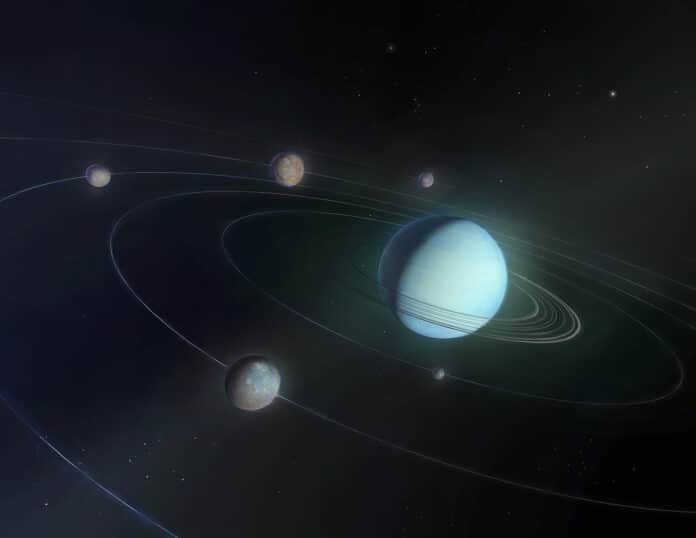Uranus is an oddity in the solar system for various reasons, but mainly because of its 28 perpendicular rotations relative to the other planets in the solar system. Researchers from the Johns Hopkins Applied Physics Laboratory (APL) in Laurel, Maryland, have recently reexamined energetic particle and magnetic field data collected by NASA’s Voyager 2 spacecraft nearly 40 years ago.
During its approximately three-day flyby of Uranus in 1986, Voyager 2 captured the only in-situ observations of the planet and its system. A new analysis of these three-decade-old observations have revealed a mysterious source of energetic ions in the planet’s magnetosphere. Their results suggest that one or two of Uranus’ 27 moons — Ariel and/or Miranda — are adding plasma into the space environment through an unknown and mysterious mechanism.
The intriguing possibility that one or both moons have oceans beneath their ice surfaces and are actively ejecting material, maybe through plumes, is one explanation.
Ian Cohen, a space scientist at APL and the lead author of the new study, said, “It isn’t uncommon that energetic particle measurements are a forerunner to discovering an ocean world.”
After diving back into the particle data from the APL-built Low-Energy Charged Particle (LECP) instrument on Voyager 2, the research team found something peculiar: a trapped population of energetic particles the spacecraft had observed while departing Uranus.
The interesting fact about these particles: they were o extremely confined near Uranus’ magnetic equator.
Cohen said, “Magnetic waves within the system would normally cause them to spread out in latitude, he explained, but these particles were all cramped near the equator between the moons Ariel and Miranda.”
“Scientists originally attributed these features to Voyager 2’s possibly having flown through a chance stream of plasma being “injected” from the distant tail of the planet’s magnetosphere. But that explanation doesn’t hold. An injection would normally have a much broader spread of particles than what was observed.”
It started to resemble a whodunit. The researchers attempted to reproduce the Voyager 2 observations using simple physical models and drawing upon over 40 years of subsequent knowledge. They concluded that the real explanation required both a potent, reliable source of particles and a certain mechanism to activate them. After weighing many alternatives, they concluded that the particles most likely originated from a nearby moon.
The team believes that Ariel and/or Miranda are responsible for the particles, either through a vapor plume resembling that of Enceladus or through a process known as sputtering, in which high-energy particles strike a surface and send more particles into space.
The energizing mechanism would, therefore, likely be the same, according to modeling: The moons continuously release particles into space, where they produce electromagnetic waves. Those waves accelerate some tiny portions of the particles to the energy that LECP can detect. The team theorizes that this procedure maintained the particles detected by LECP to be so narrowly trapped.
Cohen said, “However, with only a single observation of the region and no data about the plasma composition or measurements of the full range of electromagnetic waves within it, there’s no way to determine the source of the particles definitively.”
Yet scientists have already suspected Uranus’ five largest moons — Ariel and Miranda included — may have subsurface oceans. Voyager 2 images of both moons show physical signs of geologic resurfacing, including possible eruptions of water that froze on the surface.
Journal Reference:
- Ian James Cohen, Drew L Turner, Peter Kollmann, et al. A localized and surprising source of energetic ions in the Uranian magnetosphere 1 between Miranda and Ariel. ESS Open Archive. March 13, 2023. DOI: 10.22541/essoar.167874177.75849866/v1
